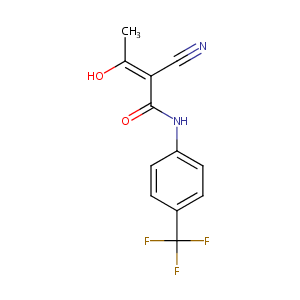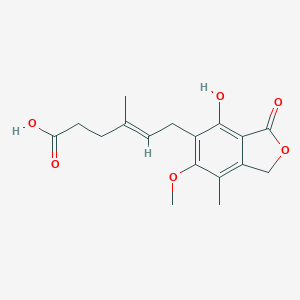| 1 |
Recurrent recessive mutation in deoxyguanosine kinase causes idiopathic noncirrhotic portal hypertension.Hepatology. 2016 Jun;63(6):1977-86. doi: 10.1002/hep.28499. Epub 2016 Mar 31.
|
| 2 |
Emerging drugs in peripheral arterial disease. Expert Opin Emerg Drugs. 2006 Mar;11(1):75-90.
|
| 3 |
Teriflunomide FDA Label
|
| 4 |
URL: http://www.guidetopharmacology.org Nucleic Acids Res. 2015 Oct 12. pii: gkv1037. The IUPHAR/BPS Guide to PHARMACOLOGY in 2016: towards curated quantitative interactions between 1300 protein targets and 6000 ligands. (Ligand id: 6844).
|
| 5 |
Drugs@FDA. U.S. Food and Drug Administration. U.S. Department of Health & Human Services. 2015
|
| 6 |
A standard database for drug repositioning. Sci Data. 2017 Mar 14;4:170029.
|
| 7 |
Early termination of a trial of mycophenolate mofetil for treatment of interstitial cystitis/painful bladder syndrome: lessons learned. J Urol. 2011 Mar;185(3):901-6.
|
| 8 |
New conjugates of mycophenolic acid and their antiproliferative activity. J Asian Nat Prod Res. 2016 Nov;18(11):1057-62.
|
| 9 |
2019 Update of the Joint European League Against Rheumatism and European Renal Association-European Dialysis and Transplant Association (EULAR/ERA-EDTA) recommendations for the management of lupus nephritis. Ann Rheum Dis. 2020 Jun;79(6):713-723.
|
| 10 |
Mycophenolic Acid overcomes imatinib and nilotinib resistance of chronic myeloid leukemia cells by apoptosis or a senescent-like cell cycle arrest. Leuk Res Treatment. 2012;2012:861301.
|
| 11 |
Thiotepa, Busulfan, and Fludarabine Conditioning Regimen in T Cell-Replete HLA-Haploidentical Hematopoietic Stem Cell Transplantation. Biol Blood Marrow Transplant. 2019 Jul;25(7):1407-1415.
|
| 12 |
Systemic Lupus Erythematosus Management in Pregnancy. Int J Womens Health. 2022 Feb 15;14:199-211.
|
| 13 |
Identification of potential drugs for diffuse large b-cell lymphoma based on bioinformatics and Connectivity Map database. Pathol Res Pract. 2018 Nov;214(11):1854-1867.
|
| 14 |
Associations between immune-suppressive and stimulating drugs and novel COVID-19-a systematic review of current evidence. Ecancermedicalscience. 2020 Mar 27;14:1022.
|
| 15 |
SARS and MERS: recent insights into emerging coronaviruses. Nat Rev Microbiol. 2016 Aug;14(8):523-34.
|
| 16 |
Expression and characterization of E. coli-produced soluble, functional human dihydroorotate dehydrogenase: a potential target for immunosuppression. J Mol Microbiol Biotechnol. 1999 Aug;1(1):183-8.
|
| 17 |
Nat Rev Drug Discov. 2013 Feb;12(2):87-90.
|
| 18 |
MDR-ABC transporters: biomarkers in rheumatoid arthritis. Clin Exp Rheumatol. 2013 Sep-Oct;31(5):779-87.
|
| 19 |
Mitochondrial dysfunction induced by leflunomide and its active metabolite. Toxicology. 2018 Mar 1;396-397:33-45.
|
| 20 |
Teriflunomide is an indirect human constitutive androstane receptor (CAR) activator interacting with epidermal growth factor (EGF) signaling. Front Pharmacol. 2018 Oct 11;9:993.
|
| 21 |
A77 1726 induces differentiation of human myeloid leukemia K562 cells by depletion of intracellular CTP pools. Mol Pharmacol. 2002 Sep;62(3):463-72. doi: 10.1124/mol.62.3.463.
|
| 22 |
Differential modulation of pro- and anti-inflammatory cytokine receptors by N-(4-trifluoromethylphenyl)-2-cyano-3-hydroxy-crotonic acid amide (A77 1726), the physiologically active metabolite of the novel immunomodulator leflunomide. Biochem Pharmacol. 1998 May 1;55(9):1523-9. doi: 10.1016/s0006-2952(97)00677-1.
|
| 23 |
Dihydroorotate dehydrogenase inhibitor A771726 (leflunomide) induces apoptosis and diminishes proliferation of multiple myeloma cells. Mol Cancer Ther. 2009 Feb;8(2):366-75. doi: 10.1158/1535-7163.MCT-08-0664. Epub 2009 Jan 27.
|
| 24 |
A Gene Expression Biomarker Predicts Heat Shock Factor 1 Activation in a Gene Expression Compendium. Chem Res Toxicol. 2021 Jul 19;34(7):1721-1737. doi: 10.1021/acs.chemrestox.0c00510. Epub 2021 Jun 25.
|
| 25 |
C-440T/T-331C polymorphisms in the UGT1A9 gene affect the pharmacokinetics of mycophenolic acid in kidney transplantation. Pharmacogenomics. 2007 Sep;8(9):1127-41.
|
| 26 |
Interaction and transport characteristics of mycophenolic acid and its glucuronide via human organic anion transporters hOAT1 and hOAT3. Biochem Pharmacol. 2007 Jun 30;74(1):161-8.
|
| 27 |
Diabetes mellitus reduces activity of human UDP-glucuronosyltransferase 2B7 in liver and kidney leading to decreased formation of mycophenolic acid acyl-glucuronide metabolite. Drug Metab Dispos. 2011 Mar;39(3):448-55.
|
|
|
|
|
|
|


